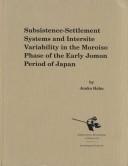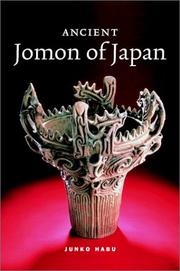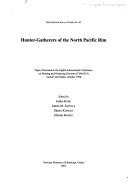| Listing 1 - 10 of 10 |
Sort by
|
Book
ISBN: 1789257638 9781789257632 Year: 2003 Publisher: Oxbow Books
Abstract | Keywords | Export | Availability | Bookmark
 Loading...
Loading...Choose an application
- Reference Manager
- EndNote
- RefWorks (Direct export to RefWorks)
A fully-illustrated introduction to the archaeology of the Jomon period in Japan, this book explores the complex relationships between Jomon people and their rich natural environment.
Book
ISBN: 4098200740 Year: 1985 Publisher: 東京 小学館
Abstract | Keywords | Export | Availability | Bookmark
 Loading...
Loading...Choose an application
- Reference Manager
- EndNote
- RefWorks (Direct export to RefWorks)

ISBN: 1879621320 9781879621329 1879621339 9781879621336 Year: 2002 Publisher: Ann Arbor International Monographs in Prehistory
Abstract | Keywords | Export | Availability | Bookmark
 Loading...
Loading...Choose an application
- Reference Manager
- EndNote
- RefWorks (Direct export to RefWorks)

ISBN: 0521772133 0521776708 Year: 2004 Volume: 4 Publisher: Cambridge New York Melbourne Cambridge university press
Abstract | Keywords | Export | Availability | Bookmark
 Loading...
Loading...Choose an application
- Reference Manager
- EndNote
- RefWorks (Direct export to RefWorks)
Despite an incredibly rich prehistory covering nearly ten thousand years, modern coverage of complex hunter-gatherer societies has tended to overlook the Jomon of Japan. This text presents an overview of the archaeology of the Jomon Period between 10,000 and 300 BC within the context of more recent complex hunter-gatherer societies. It bridges the gap between academic traditions in Japanese and Anglo-American archaeology and represents an invaluable source of reflection on the development of human complexity.
Jōmon culture. --- Japan --- Antiquities. --- Jōmon culture --- Jōmonshiki culture --- Neolithic period
Book
ISBN: 0932206956 Year: 1983 Publisher: Ann Arbor, Michigan : Museum of Anthropology, University of Michigan,
Abstract | Keywords | Export | Availability | Bookmark
 Loading...
Loading...Choose an application
- Reference Manager
- EndNote
- RefWorks (Direct export to RefWorks)
Paleobotany --- Plant remains (Archaeology) --- Jōmon culture --- Japan --- Japan. --- Kameda Peninsula (Japan) --- Antiquities. --- Paleoethnobotany --- Jomon culture
Book
Year: 2003 Publisher: National Museum of Ethnology
Abstract | Keywords | Export | Availability | Bookmark
 Loading...
Loading...Choose an application
- Reference Manager
- EndNote
- RefWorks (Direct export to RefWorks)
Hunting and gathering societies --- Excavations (Archaeology) --- Jōmon culture --- Pacific Area --- Japan --- Antiquities

ISBN: 4901906070 Year: 2003 Publisher: Osaka National museum of ethnology
Abstract | Keywords | Export | Availability | Bookmark
 Loading...
Loading...Choose an application
- Reference Manager
- EndNote
- RefWorks (Direct export to RefWorks)
Excavations (Archaeology) --- Hunting and gathering societies --- Jōmon culture --- Japan --- Pacific Area --- Antiquities

ISBN: 1789201705 1879621320 1879621339 Year: 2001 Publisher: Berghahn Books
Abstract | Keywords | Export | Availability | Bookmark
 Loading...
Loading...Choose an application
- Reference Manager
- EndNote
- RefWorks (Direct export to RefWorks)
This book examines the settlement patterns and intersite variability in lithic assemblages of Early Jomon (ca. 5000 BP) hunter-gatherers in Japan. A model is proposed that links regional settlement patterns and intersite lithic assemblage variability to residential mobility. The results of this study suggest that the Early Jomon people were not sedentary, as previously assumed, but instead moved their residential basis seasonally. The implications of this result are discussed in the context of the development of hunter-gatherer cultural complexity in general and the course of Japanese prehistory in particular.
Hunting and gathering societies --- Jōmon culture. --- Assemblage Variability. --- Cultural Complexity. --- Hunter-Gatherers. --- Intersite Lithic. --- Japanese Prehistory. --- Residential Mobility.
Book
ISBN: 131543220X 1315432218 1598746588 9781598746587 9781598743357 159874335X 9781315432212 Year: 2011 Publisher: Walnut Creek, California
Abstract | Keywords | Export | Availability | Bookmark
 Loading...
Loading...Choose an application
- Reference Manager
- EndNote
- RefWorks (Direct export to RefWorks)
This is the first volume to introduce the data, theory and methodology of contemporary archaeological work in Japan and other parts of East Asia archaeology in English to western audiences. It also introduces a new theoretical concept to archaeologists interested in the relationship between ancient cultures-coexistence. Archaeologists traditionally examine the boundaries between different cultural groups in terms conflict and dominance rather than long-term, harmonious adaptive responses. Chapters in this book cover evidence from burials, faunal and botanical analysis, as well as traditio
Yayoi culture --- Jōmon culture --- Culture diffusion --- International relations --- Excavations (Archaeology) --- Archaeological digs --- Archaeological excavations --- Digs (Archaeology) --- Excavation sites (Archaeology) --- Ruins --- Sites, Excavation (Archaeology) --- Archaeology --- Cultural diffusion --- Diffusion of culture --- Culture --- Social change --- Jōmonshiki culture --- Neolithic period --- Yayoishiki culture --- East Asia --- Asia, East --- Asia, Eastern --- East (Far East) --- Eastern Asia --- Far East --- Orient --- Antiquities
Book
ISBN: 3447043296 Year: 2000 Publisher: Wiesbaden Harrassowitz
Abstract | Keywords | Export | Availability | Bookmark
 Loading...
Loading...Choose an application
- Reference Manager
- EndNote
- RefWorks (Direct export to RefWorks)
J2161.911 --- J3311 --- J1700.10 --- J4000.10 --- Japan: Archaeology and antiquities -- Kodai -- Jōmon ( -300 BC), and earlier --- Japan: History -- Kodai -- Jōmon ( -300 BC) and earlier --- Japan: Religion in general -- history -- Kodai, prehistoric and ancient, premodern --- Japan: Social history, history of civilization -- Kodai, prehistoric and ancient, premodern --- Jōmon culture. --- Religion, Prehistoric --- Antiquities. --- Japan --- Jōmon culture --- J2161.11 --- Prehistoric religion --- Jōmonshiki culture --- Neolithic period --- Antiquities
| Listing 1 - 10 of 10 |
Sort by
|

 Search
Search Feedback
Feedback About UniCat
About UniCat  Help
Help News
News